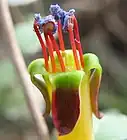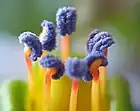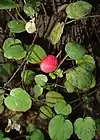Fuchsia procumbens
Fuchsia procumbens is a prostrate shrub that is endemic to coastal areas of the North Island of New Zealand. Common names include creeping fuchsia, climbing fuchsia or trailing fuchsia.[3]
| Fuchsia procumbens | |
|---|---|
 | |
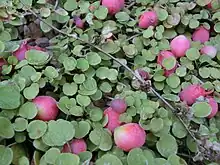 | |
| Scientific classification | |
| Kingdom: | Plantae |
| Clade: | Tracheophytes |
| Clade: | Angiosperms |
| Clade: | Eudicots |
| Clade: | Rosids |
| Order: | Myrtales |
| Family: | Onagraceae |
| Genus: | Fuchsia |
| Species: | F. procumbens |
| Binomial name | |
| Fuchsia procumbens | |
| Synonyms[2] | |
| |
Description
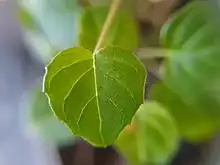
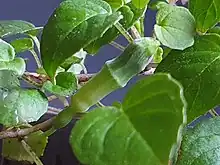
Vegetative characteristics
Its stems are slender, creeping, and weakly woody. They can climb heights of close to 1 m on small shrubs.[4] The circular, 7-12 mm big leaves, which are attached singly to the stem, have dentate leaf margins, as well as trichomes on the surface.[5]
Generative characteristics
The erect, radially symmetrical flowers with a yellow floral tube do not have any petals. Instead, it has four sepals, which display orange and green coloration.[5][4] This contrasts with the blue pollen, which is a distinctive character of the Pacific Fuchsia clade.[4] The pollen is producen in eight stamens.[5]
Habitat
Small populations occur in coastal areas of New Zealand's northern island. It grows in sand in proximity to the tide lines.[6]
Ecology
Phylogeny
It belongs to a South Pacific lineage that diverged from all other Fuchsia species around 30 million years ago. Fuchsia procumbens diverged from the other New Zealand (and Tahitian) species around 18 million years ago.[1]
Cladogram
The following relationships were reported:[1]
| |||||||||||||||||||
Reproduction
Fuchsia procumbens is trioecious (i.e. subdioecious). Hermaphrodite, male, and female plants occur. Both male and female plants have two different types, which differ in the length of the style.[9] Unisexual populations are thought to be able to persevere due to the vegetative reproduction by rooting along the creeping stems.[4]
Taxonomy
Synonym status of Fuchsia kirkii
The species Fuchsia kirkii was described by Joseph Hooker in 1871 based on the male form of Fuchsia procumbens. Thereafter he recognized sexual dimorphism as the source of the perceived differences between the species.[4]
Section Procumbentes
In the year 1995 Fuchsia procumbens was placed in the monotypic section Procumbentes due to significant differences from the remaining Pacific Fuchsia clade.[4]
Etymology
The specific epithet procumbens refers to the sprawling growth habit of the plant.[3]
Cytology
The diploid chromosome count is 2n = 22.[10]
Conservation
It has been categorized as "At risk – naturally uncommon" by the Threatened and uncommon plants of New Zealand list of 2009.[11]
Uses
Fruit
The small, red, crunchy fruit is edible, although rarely eaten. It has been described as slimy and bland.[12]
Horticulture
It is commonly cultivated in gardens.[4]
References
- Berry, Paul E.; William J. Hahn; Kenneth J. Sytsma; Jocelyn C. Hall & Austin Mast (2004). "Phylogenetic relationships and biogeography of Fuchsia (Onagraceae) based on noncoding nuclear and chloroplast DNA data". American Journal of Botany. 91 (4): 601–14. doi:10.3732/ajb.91.4.601. PMID 21653416.
- "Fuchsia procumbens R.Cunn". The Plant List. Retrieved 5 July 2014.
- De Lange, P. J. (2023). Fuchsia procumbens. New Zealand Plant Conservation Network. Retrieved April 5, 2023, from https://www.nzpcn.org.nz/flora/species/fuchsia-procumbens/
- Godley, E. J., & Berry, P. E. (1995). "The biology and systematics of Fuchsia in the South Pacific." Annals of the Missouri Botanical Garden, 473-516.
- Fuchsia procumbens - The University of Auckland. (n.d.). Retrieved April 5, 2023, from https://www.nzplants.auckland.ac.nz/en/about/seed-plants-flowering/onagraceae/fuchsia-procumbens.html
- Mosyakin, S. L., de Lange, P., Antonenko, S. L., & Klimovych, N. B. (2020). "Types and other historical specimens of Allan and Richard Cunningham's taxa of Epilobium and Fuchsia (Onagraceae) from New Zealand in the Turczaninow Herbarium at the National Herbarium of Ukraine (KW)."
- Whitaker, A. H. (1987). "The roles of lizards in New Zealand plant reproductive strategies." New Zealand journal of botany, 25(2), 315-328.
- Fuchsia procumbens. (n.d.). Auckland Botanic Gardens. Retrieved April 5, 2023, from https://www.aucklandbotanicgardens.co.nz/plants-for-auckland/plants/fuchsia-procumbens/
- Godley, E. J. (1955). "Breeding Systems in New Zealand Plants: I. Fuchsia." Annals of botany, 19(4), 549-559.
- Fuchsia procumbens R. Cunn. ex A. Cunn. (n.d.). Tropicos.org. Missouri Botanical Garden. Retrieved April 2, 2023, from http://legacy.tropicos.org/Name/23202018?tab=chromosomecounts
- Young, M. (2009). "Botany of some of the islands in the eastern Bay of Islands, Northern New Zealand: an update." Auckland Botanical Society Journal, 64, 88-97.
- "Fuchsia procumbens "Creeping Fuchsia"". Annie's Annuals. Retrieved 9 February 2021.
